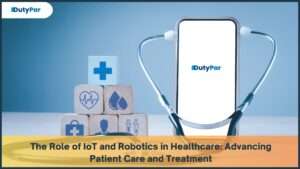 The healthcare industry is constantly evolving, and the latest advancements in technology are revolutionizing the way healthcare is delivered to patients. One such advancement is the integration of the Internet of Things (IoT) and robotics in healthcare, which has significantly improved patient care and treatment. In this article, we will explore the role of IoT and robotics in healthcare and its impact on patient care and treatment.
The healthcare industry is constantly evolving, and the latest advancements in technology are revolutionizing the way healthcare is delivered to patients. One such advancement is the integration of the Internet of Things (IoT) and robotics in healthcare, which has significantly improved patient care and treatment. In this article, we will explore the role of IoT and robotics in healthcare and its impact on patient care and treatment.
What is IoT?
The Internet of Things (IoT) refers to the interconnection of devices, machines, and sensors through the internet, enabling them to collect, analyze, and share data.
IoT has transformed many industries, and the healthcare industry is no exception. In healthcare, IoT devices have been used to collect patient data and provide insights that can be used to improve patient care and treatment.
IoT in Healthcare
IoT devices have made it possible for healthcare providers to monitor patients remotely, leading to improved patient outcomes and reduced healthcare costs.
For instance, patients can now wear wearable devices that monitor their vitals, such as heart rate, blood pressure, and temperature, and send the data to their healthcare provider for analysis.
The data collected can be used to identify health risks and help prevent or manage chronic conditions.
IoT devices have also made it easier for healthcare providers to track medication adherence. Patients can now be reminded to take their medication through mobile apps, and their adherence to the medication can be tracked through IoT devices.
This has led to better medication management and reduced hospital admissions due to medication non-adherence.
Robotics in Healthcare
Robotics is another technological advancement that has had a significant impact on healthcare.
Robots are now being used in various healthcare settings, from hospitals to clinics, to assist with patient care and treatment.
Robotics has made it possible for healthcare providers to automate repetitive tasks, enabling them to focus on more critical tasks that require human expertise.
Robots are also being used in surgical procedures, leading to improved surgical outcomes and reduced recovery times. Robotic surgery allows for more precise incisions and reduces the risk of complications during surgery.
The use of robotics in surgery has also made it possible for surgeons to perform minimally invasive procedures, leading to reduced pain, scarring, and shorter hospital stays for patients.
Data Analytics and IoT
The integration of data analytics with IoT devices has enabled healthcare providers to gain insights into patient data and use that data to improve patient care and treatment.
Data analytics can be used to identify patterns in patient data, enabling healthcare providers to detect health risks early and prevent or manage chronic conditions effectively.
Data analytics can also be used to track healthcare provider performance and identify areas that need improvement. This has resulted in better patient outcomes and lower healthcare expenses.
Telemedicine and IoT
Telemedicine is another area where IoT devices have had a significant impact on healthcare.
Telemedicine is the use of technology to offer healthcare remotely. IoT devices have made it possible for healthcare providers to remotely monitor patients and provide healthcare services without the need for in-person visits.
Patients can now consult with their healthcare providers through video conferencing, and their vitals can be remotely monitored through IoT devices. This has led to improved patient access to healthcare services, especially for patients in remote areas.
Artificial Intelligence and IoT
Artificial Intelligence (AI) is another area where IoT devices have been integrated into healthcare.
AI algorithms can be used to analyze patient data collected through IoT devices, enabling healthcare providers to identify health risks and predict outcomes.
AI algorithms can also be used to personalize patient care and treatment, leading to improved patient outcomes.
For instance, AI can be used to develop personalized treatment plans based on patient data, such as their medical history, genetics, and lifestyle factors.
Challenges of IoT and Robotics in Healthcare
Although IoT and robotics have had a significant impact on healthcare, there are some challenges that need to be addressed.
One challenge is data privacy and security. As more patient data is collected through IoT devices, there is a risk of that data being compromised, leading to privacy and security concerns.
Another challenge is the cost of implementing IoT and robotics in healthcare. The initial investment required to implement these technologies can be high, and some healthcare providers may not have the resources to invest in them.
Additionally, the integration of IoT and robotics in healthcare requires healthcare providers to adapt to new technologies and workflows.
This can be challenging for healthcare providers who may be resistant to change or may not have the necessary skills to use these technologies effectively.
Conclusion
IoT and robotics have significantly improved patient care and treatment in the healthcare industry. IoT devices have made it possible for healthcare providers to collect patient data remotely, leading to improved patient outcomes and reduced healthcare costs.
Robotics has made it possible to automate repetitive tasks and perform minimally invasive surgical procedures, leading to improved surgical outcomes and reduced recovery times.
The integration of data analytics, telemedicine, and artificial intelligence with IoT devices has also led to improved patient care and treatment.
However, there are challenges that need to be addressed, such as data privacy and security concerns and the cost of implementing these technologies. Healthcare providers need to adapt to new technologies and workflows to effectively integrate IoT and robotics into healthcare.
Download: Dutypar Attendance App
